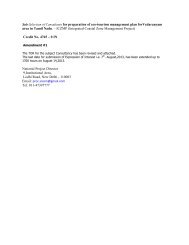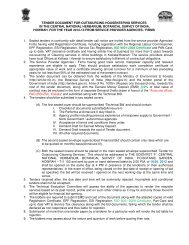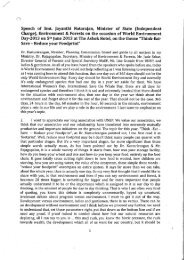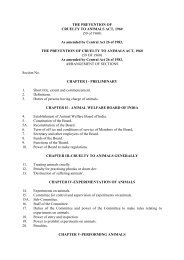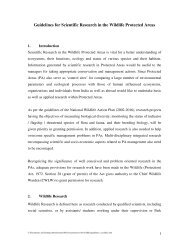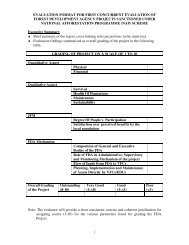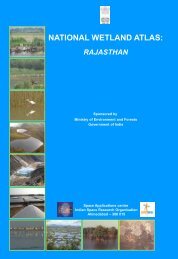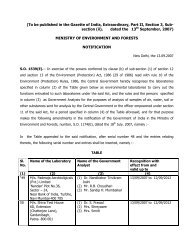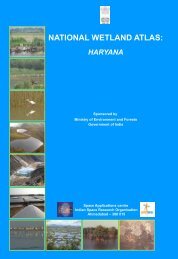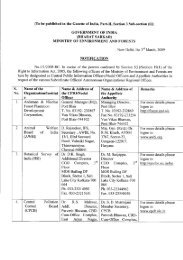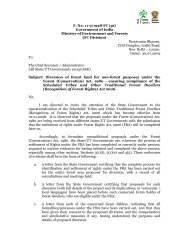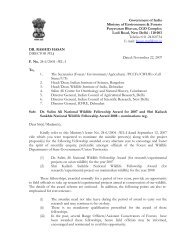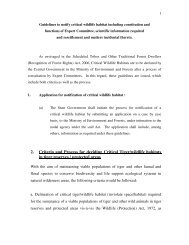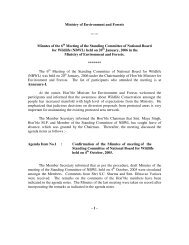Hazardous Materials (Management, Handling and Transboundary ...
Hazardous Materials (Management, Handling and Transboundary ...
Hazardous Materials (Management, Handling and Transboundary ...
Create successful ePaper yourself
Turn your PDF publications into a flip-book with our unique Google optimized e-Paper software.
[To be published in the Gazette of India, Extraordinary, Part-II,Section-3, Sub-section (ii) dated the 28 September 2007]Government of IndiaMINISTRY OF ENVIRONMENT AND FORESTSNOTIFICATIONNew Delhi, the 28 September 2007S.O. 1676 (E) WHEREAS by notification of the Government of India in the Ministryof Environment <strong>and</strong> Forests <strong>Hazardous</strong> Wastes (<strong>Management</strong> <strong>and</strong> <strong>H<strong>and</strong>ling</strong>)Rules, 1989, vide, S.O. 594(E) dated the 28 th July 1989 as amended from time totime imposed restrictions <strong>and</strong> prescribed procedures for management, h<strong>and</strong>ling<strong>and</strong> disposal of hazardous wastes.AND WHEREAS, the Central Government considers it necessary in the publicinterest <strong>and</strong> to address sustainable development concerns, to review the rulespublished earlier, to enable the recovery <strong>and</strong>/or reuse of useful materials fromhazardous materials generated from a process, thereby, reducing the hazardouswastes destined for final disposal <strong>and</strong> to ensure the environmentally soundmanagement of all hazardous materials.DRAFT RULESAND WHERESAS the following draft rules, which the Central Governmentproposes to make in exercise of the powers conferred in clause (c) <strong>and</strong> (d) ofsub-section (2) of sections 6, 8 <strong>and</strong> 25 of the Environment (Protection) Act, 1986(29 of 1986), <strong>and</strong> in supersession of the <strong>Hazardous</strong> Wastes (<strong>Management</strong> <strong>and</strong><strong>H<strong>and</strong>ling</strong>) Rules, 1989, is hereby published for information of the public likely tobe affected thereby; <strong>and</strong> notice is hereby given that the said draft rules will betaken into consideration by the Central Government after expiry of a period ofsixty days form the date of publication of this notification in the Official Gazette;The objections or suggestions which may be received from any person in respectof the said draft rules before the period specified will be taken into considerationby the Central Government.Any person desirous of making any objection or suggestion with respect to thesaid draft rules may forward the same within the period so specified to theSecretary, Ministry of Environment <strong>and</strong> Forests, Paryavaran Bhawan, CentralGovernment Offices Complex, New Delhi-110003.CHAPTER - IPRELIMINARY1
1. Short title <strong>and</strong> commencement.- (1) These rules may be called the<strong>Hazardous</strong> <strong>Materials</strong> (<strong>Management</strong>, <strong>H<strong>and</strong>ling</strong> <strong>and</strong> <strong>Transboundary</strong> Movement)Rules, 2007.(2) They shall come into force on the date of their publication in the officialGazette.2. Application.- These rules shall apply to the h<strong>and</strong>ling of hazardousmaterials or wastes as specified in Schedules <strong>and</strong> shall not apply to-(a) Waste-water <strong>and</strong> exhaust gases as covered under the provisions of theWater (Prevention <strong>and</strong> Control of Pollution) Act, 1974 (6 of 1974) <strong>and</strong> the Air(Prevention <strong>and</strong> Control of Pollution) Act, 1981 (14 of 1981) <strong>and</strong> rules madethereunder;(b) Wastes arising out of the operation from ships beyond five kilometres ofthe relevant baseline as covered under the provisions of the Merchant ShippingAct,. 1958 (44 of 1958) <strong>and</strong> the rules made thereunder;(c) Radio-active wastes as covered under the provisions of the Atomic EnergyAct, 1962 (33 of 1962) <strong>and</strong> rules made thereunder;(d) Bio-medical wastes covered under the Bio-Medical Wastes (<strong>Management</strong><strong>and</strong> <strong>H<strong>and</strong>ling</strong>) Rules, 1998 made under the Act;(e) Wastes covered under the Municipal Solid Wastes (<strong>Management</strong> <strong>and</strong><strong>H<strong>and</strong>ling</strong>) Rules, 2000 made under the Act;3. Definitions.- (1) In these rules, unless the context otherwise requires, -(a) “Act” means the Environment (Protection) Act, 1986 (29 of 1986);(b) “Basel Convention” is the United Nations Environment Programme (UNEP)Convention on the Control of <strong>Transboundary</strong> Movement of <strong>Hazardous</strong>Wastes <strong>and</strong> their Disposal;(c)“Central Pollution Control Board” means the Central Pollution ControlBoard constituted under sub-section (1) of section 3 of the Water(Prevention <strong>and</strong> Control of Pollution) Act, 1974 (6 of 1974);(d) “disposal” means treatment <strong>and</strong> deposition of any hazardous wastes onl<strong>and</strong>;(e)“export” with its grammatical variations <strong>and</strong> cognate expressions, meanstaking out of India to a place outside India:2
(f)(g)(h)(i)(j)(k)(l)“exporter” means any person under the jurisdiction of the exportingcountry who exports hazardous materials including the country, whoexports hazardous materials;“environmentally sound management of hazardous materials or wastes”means taking all steps required to ensure that the hazardous materials orwastes are managed in a manner which shall protect health <strong>and</strong> theenvironment against the adverse effects which may result from suchmaterials;“environmentally sound technologies” means any technology approvedby the Central Pollution Control Board <strong>and</strong> included in its guidelines fromtime to time;“facility” means any location wherein the processes incidental to thegeneration, collection, reception, treatment, storage <strong>and</strong> disposal ofhazardous wastes are carried out;“Form” means a form appended to these rules;“hazardous materials” means any material which conform to one or morecriteria set forth in Schedule I or contains or contaminated withhazardous constituents listed in Schedule II exceeding the concentrationlimits indicated therein;“hazardous waste” means any waste which are destined for final disposal<strong>and</strong> conform to one or more criteria set forth in Schedule I or contains orcontaminated with hazardous constituents listed in Schedule II exceedingthe concentration limits indicated therein;(m) “hazardous wastes site” means a place for collection, reception,treatment, storage <strong>and</strong> disposal to the environment of hazardous wasteswhich has been duly approved by the competent authority;(n)(o)(p)(q)“illegal traffic” means any transboundary movement of hazardous wastesas specified in rule 15;“import” with its grammatical variations <strong>and</strong> cognate expressions, meansbringing into India from a place outside India;“importer” means an occupier or any person who imports hazardousmaterials;“license” means a written or printed permission granted by the CentralGovernment in the Ministry of Environment <strong>and</strong> Forests or an authoritydesignated by it for this purpose;3
(r)(s)“manifest” means transporting document prepared <strong>and</strong> signed by theoccupier in accordance with rule 7;“occupier” in relation to any factory or premises, means a person whohas, control over the affairs of the factory or the premises an includes inrelation of any substance, the person in possession of the substance;(t) “operator of facility” means a person who owns or operates a facility forcollection, reception, treatment, storage or disposal of hazardous wastes;(u)“recycler” means an occupier who procures <strong>and</strong> processes hazardousmaterials for recovery;(v) “recycling” means reclamation <strong>and</strong> reprocessing of hazardous materialsfrom a production process in an environmentally sound manner for theoriginal purpose or for other purposes.(w) “reuse” means hazardous materials that are used for the purpose for itsoriginal use or another use.(x)(y)“registered recycler or re-refiner or reuser” means a recycler or re-refineror reuser registered for reprocessing hazardous material with the CentralGovernment in the Ministry of Environment <strong>and</strong> Forests or the CentralPollution Control Board, as the case may be, for recycling or reprocessinghazardous materials;“recovery” means to any operation in the recycling activity whereinspecific materials are recovered;(z) “safe for recycling” means any hazardous material not containinghazardous constituents more than sixty percent of the recoverablematerials <strong>and</strong> recycled using environmentally sound technologies;(za) “Schedule” means a Schedules appended to these rules;(zb) “State Government” in relation to a Union territory means, theAdministrator thereof appointed under article 239 of the Constitution;(zc) “State Pollution Control Board or Committee” means the Board orCommittee constituted under sub-section (1) of section 4 of theWater(Prevention <strong>and</strong> Control of Pollution) Act, 1974 (6 of 1974);(zd) “State of transit” means any State, other than the State of export orimport, through which a movement of hazardous wastes or otherwastes is planned or takes place;4
(ze)(zf)(zg)“storage” means storing any hazardous materials in a licensed storagefacility for a temporary period, at the end of which such materials areprocessed;“transboundary movement” means any movement of hazardousmaterials or wastes or other wastes from an area under the jurisdictionof one country to or through an area under the jurisdiction of anothercountry or to or through an area not under the jurisdiction of anycountry, provided at least two countries are involved in the movement;“transport” means off-site movement of hazardous materials or wastesby air, rail, road or water;(zh) “transporter” means a person engaged in the off-site transportation ofhazardous materials by air, rail, road or water;(zi)“treatment” means a method, technique or process, designed to modifythe physical, chemical or biological characteristics or composition of anyhazardous material so as to reduce its potential to cause harm;(zj) “wastes” are materials which are disposed of, or intended to be disposedof, or required to be disposed of, to the environment.(2) Words <strong>and</strong> expressions used in these rules <strong>and</strong> not defined but defined in theAct shall have the meanings respectively assigned to them in the Act.'CHAPTER - IIIMPORT AND EXPORT OF HAZARDOUS MATERIALS4. <strong>Transboundary</strong> movement (import <strong>and</strong> export) of hazardousmaterials.- The Ministry of Environment <strong>and</strong> Forests shall be the nodal Ministryto deal with the trans-boundary movement of all hazardous materials <strong>and</strong> to grantpermission of transit of hazardous materials through any part of India.5. Import <strong>and</strong> export hazardous wastes.- (1) Import of hazardous wastesfrom any country to India for disposal shall not be permitted.(2) Export of hazardous wastes from India is allowed to an actual user of thewastes or operator of disposal facility with the Prior Informed Consent of theimporting country to ensure environmentally sound management of the hazardouswaste in question.6. Import <strong>and</strong> export of hazardous material.- (1) The hazardous materialsnot listed as a hazardous waste in Part A <strong>and</strong> Part B of Schedule III, of theserules <strong>and</strong> which do not exhibit hazard characteristics specified in Part C of that5
Schedule shall be allowed for imports to actual users licensed by Central PollutionControl Board for its reuse, recycling or reprocessing under these rules.(2) The hazardous materials listed as hazardous wastes in Part A <strong>and</strong> B ofSchedule III or which exhibit one or more hazard characteristics specified in PartC of that Schedule shall be regulated for imports <strong>and</strong> exports.(3) All hazardous materials listed in Part B of Schedule III not containing orcontaminated with hazardous materials specified in Part B of that Schedule <strong>and</strong>which exhibit one or more of the hazard characteristics specified in Part C of thatSchedule are safe for recycling shall be free for import <strong>and</strong> export;(4) All hazardous materials listed in Part B of Schedule III containing orcontaminated with hazardous materials of Schedule I or Schedule II or Part A ofSchedule III <strong>and</strong> which exhibit one or more hazard characteristics specified in PartC of Schedule III <strong>and</strong> are recyclable shall be allowed for imports for recycling byunits having a valid license for recycling under rule 12 of these rules. Such importshall require a Prior Informed Consent in writing from the importing country’scompetent authority. All exports of such hazardous materials mentioned in subrules4 shall also require Prior Informed Consent in writing for such exports.(5) The import of hazardous materials listed in Part A <strong>and</strong> B of Schedule IIIwhich are containing or contaminated with hazardous materials <strong>and</strong> which exhibitone or more hazards characteristics specified in Part C of that Schedule <strong>and</strong> arenot safe for recycling or reuse shall be considered as hazardous waste <strong>and</strong> shallnot be permitted for imports in any circumstances.(6) The Schedule IV containing “list of hazardous materials for recycling,reprocessing <strong>and</strong> reuse” is only an indicative list of hazardous materials suitablefor recycling, reprocessing <strong>and</strong> reuse <strong>and</strong> in case any other hazardous material isproposed to be imported the Ministry of Environment <strong>and</strong> Forests shall determinewhether the hazardous material is a waste, in that case the same shall not beallowed to be imported <strong>and</strong> in case the hazardous material is not a waste, it maybe allowed in accordance with the provisions of these rules.(7) The import of hazardous materials listed in Schedule V shall not bepermitted.7. Illegal Traffic.- (1) The export of hazardous wastes from India shall bedeemed illegal:(i) if it is without permission of the Central Government; or(ii) if the permission has been obtained through falsification, misrepresentationor fraud; or(iii) it does not conform to the shipping details provided in the notification<strong>and</strong> movement document;6
(2) Import of hazardous wastes shall not be permitted <strong>and</strong> any such importshall be treated as a case of illegal traffic.(3) In case of illegal import of hazardous wastes the importer shall re-exportthe waste in question within a period of thirty days from the date of its arrival intoIndia.CHAPTER - IIIPROCEDURES FOR IMPORT AND EXPORT OF HAZARDOUS MATERIALS8. Procedure for export of hazardous wastes from India.- (1) Anexporter shall communicate in Form 1 to the Central Government in the Ministryof Environment <strong>and</strong> Forests of the proposed transboundary movement ofhazardous wastes together with the Prior Informed Consent in writing from theimporting country <strong>and</strong> a legal bond or full cover insurance policy for theconsignment.(2) On receipt of such documentation, after authentication of the same, theCentral Government shall give a ‘No Objection Certificate’ to the proposed export<strong>and</strong> may impose conditions as it may consider necessary.(3) The Central Government, shall forward a copy of the ‘No ObjectionCertificate’ granted, to the Central Pollution Control Board, the concerned StatePollution Control Board, Pollution Control Committee of the UT <strong>and</strong> the concernedPort <strong>and</strong> Customs authorities for ensuring compliance of the conditions if any ofexport <strong>and</strong> to take appropriate steps for safe h<strong>and</strong>ling of the waste shipment.(4) The exporter shall ensure that no consignment is shipped before the ‘NoObjection Certificate’ is received.(5) The exporter shall also ensure that the shipment is accompanied with theMovement Document, Form 2.9. Procedure for Export of <strong>Hazardous</strong> materials requiring PriorInformed Consent. - (1) The exporter of hazardous material shall apply at leastninety days in advance in Form 1 to the Central Government in the Ministry ofEnvironment <strong>and</strong> Forests, seeking permission for the proposed export <strong>and</strong>transboundary movement.(2) The Central Government, on receipt of the Form 1 accompanied by PriorInformed Consent in writing from the importing country <strong>and</strong> a test report from anaccredited laboratory of analysis of the hazardous material consignment inquestion shall, after due verification of the facts, grant permission for export byissuing ‘No Objection Certificate’ in Form-1.(3) The exporter shall ensure that no consignment is shipped prior to therequisite authentication being received.7
(4) The exporter shall also ensure that the shipping document is accompaniedwith Form 2, an authenticated copy of Form 1, ‘No Objection Certificate' <strong>and</strong> anauthenticated copy of the test report from an accredited laboratory of analysis ofthe hazardous material.(5) The exporter of hazardous materials shall also submit a bond or aninsurance certificate covering full third party liability during the transboundarymovement.(6) The exporter shall inform the Central Government in the Ministry ofEnvironment <strong>and</strong> Forest upon completion of the transboundary movement.10. Procedure for import of hazardous materials for recyclingrequiring Prior Informed Consent.- (1) Every recycler having valid licensefrom Central Pollution Control Board to recycle hazardous materials <strong>and</strong> seekingpermission to import such materials, shall apply to the State Pollution ControlBoard or Committee at least one hundred <strong>and</strong> twenty days in advance of theintended import in Form 1 & 3;(2) The State Pollution Control Board shall forward the application withrecommendations <strong>and</strong> requisite stipulations for safe transport, storage <strong>and</strong>processing, to the Central Government in the Ministry of Environment <strong>and</strong> Forestswithin a period of thirty days of receipt of the application;(3) The Central Government after satisfying itself, that all relevant provisions ofthe rules are fulfilled, may grant ‘No Objection Certificate’ for the import <strong>and</strong>authenticate copy of Form 1 subject to the following:(i) the hazardous material in question is covered under Basel Convention;(ii) the importer submits a valid Prior Informed Consent letter along withauthenticated copy of Form 1 from the concerned authority of theexporting country; <strong>and</strong>(iii) possesses a valid license from Central Pollution Control Board forundertaking the import in question.(4) The Central Government shall forward a copy of the ‘No ObjectionCertificate’ granted, to the Central Pollution Control Board, the concerned StatePollution Control Board or Pollution Control Committee of UT <strong>and</strong> the concernedPort <strong>and</strong> Customs authorities for ensuring compliance of the conditions of imports<strong>and</strong> safe h<strong>and</strong>ling of the hazardous materials.(5) The Central Government shall communicate the grant of permission byauthentication in Form 1 to the exporter <strong>and</strong> the competent authority of exportingcountry <strong>and</strong> endorse a copy of the same to the Central Pollution Control Board<strong>and</strong> the State Pollution Control Board or Pollution Control Committees of UT asthe case may be.8
(6) The Port <strong>and</strong> Custom authorities shall ensure that shipment is accompaniedby the Movement Document, Form 2 <strong>and</strong> the test report from a laboratoryaccredited by the concerned authority of the exporting country of analysis of thehazardous materials consignment in question.(7) The Custom authorities shall collect <strong>and</strong> retain in safe custody, threer<strong>and</strong>omly drawn samples of the consignment for a period of five years, in order toensure that in the event of any dispute as to whether the consignment conformsto the declaration made in the notification <strong>and</strong> Movement Document Form 2.(8) The recycler, importing hazardous materials, shall maintain the records ofhazardous material imported as specified in Form 4 <strong>and</strong> the record so maintainedshall be available for inspection by the State Pollution Control Boards or PollutionControl Committees of UT as the case may be.11. Freely importable materials for recycling.- (1) The following itemsdestined for recycling shall be freely importable:(i)(ii)items placed under “free category” in Notifications issued by theDirectorate General of Foreign Trade;hazardous materials listed under an ‘Open General License’ of theDirectorate General of Foreign Trade shall only be imported by thoseunits who have been granted license for recycling by the CentralPollution Control Board or any other authority or agency designated bythe Central Government in the Ministry of Environment <strong>and</strong> Forests inaccordance with the procedure laid down under rule 7.CHAPTER - IVPROCEDURE FOR HANDLING HAZARDOUS MATERIALS12. Responsibilities of the occupier for h<strong>and</strong>ling of hazardousmaterials.- (1) The occupier shall be responsible for safe <strong>and</strong> environmentallysound h<strong>and</strong>ling of all hazardous materials generated in his establishment.(2) All hazardous waste generated in the establishment of an occupier shall besent to a licensed facility for disposal.(3) All hazardous wastes transported from an occupier’s establishment to alicensed facility for disposal shall be transported by a transporter licensed forcarrying hazardous waste in question.(4) The occupier or any other person acting on his behalf who intends to get hishazardous waste treated by the operator of a facility Treatment Storage DisposalFacility, shall give, to the operator of a facility, such information as may bedetremined by the State Pollution Control Board.9
(5) The occupier shall take all adequate steps while h<strong>and</strong>ling hazardousmaterials to -(i) contain contaminants <strong>and</strong> prevent accidents <strong>and</strong> limit theirconsequences on humans <strong>and</strong> the environment; <strong>and</strong>(ii) provide persons working on the site with information, training <strong>and</strong>equipment necessary to ensure their safety.(6) The Authority specified in Column 2 of the Schedule VI shall to perform theduties as specified in Column 3 of the Schedule subject to the provisions of theserules.CHAPTER - VPROCEDURE FOR RECYCLING OR REUSE OF HAZARDOUS MATERIALS.13. Procedure for Grant of License for recyclers or re-users.- (1) Everyperson desirous of recycling or reusing hazardous materials shall make anapplication in Form 5 along with a copy each of the following documents to theCentral Pollution Control Board for the grant of license or renewal of license torecycle or reuse hazardous materials -(i)(ii)letters of consents granted under the Water (Prevention <strong>and</strong> Control ofPollution) Act, 1974 or the Air (Prevention <strong>and</strong> Control of Pollution) Act,1981 as the case may be;certificate of registration with District Industries Centre or IndustrialLicense, if applicable;(iii) proof of installed capacity of plant <strong>and</strong> machinery issued by the DistrictIndustries Centre; <strong>and</strong>(iv) in case of renewal, certificate of compliance of effluent <strong>and</strong> emissionst<strong>and</strong>ards <strong>and</strong> treatment <strong>and</strong> disposal of hazardous wastes, asapplicable, from the State Pollution Control Board or the PollutionControl Committee of UT.(2) The Central Pollution Control Board, on being satisfied that the recyclerspossess adequate technical capabilities, requisite facilities, <strong>and</strong> equipment torecycle or reuse hazardous materials, shall grant a License to such recyclers or reusers,stipulating therein necessary conditions for safe operation.(3) The Central Pollution Control Board shall dispose of the application forlicense within a period of one hundred <strong>and</strong> twenty days of receipt of suchapplication with complete details, after providing an opportunity to the applicantto present his case before the Central Pollution Control Board, <strong>and</strong> assign reasonsfor the decision.10
(4) The Central Pollution Control Board may cancel or suspend the Licensegranted under these rules, if in it has reasons to believe that the recycler hasfailed to comply with any of the conditions of the license, or with any provisions ofthe Act or rules made there under;(5) The recycler <strong>and</strong> the re-user shall maintain record of hazardous materialpurchased <strong>and</strong> processed <strong>and</strong> shall file an annual return for the period April toMarch in Form-6 to the respective State Pollution Control Board or PollutionControl Committee of UT, on or before the 30 th day of June of every year.(6) All licenses issued to recyclers <strong>and</strong> re-users shall be valid for ten years.14. Conditions for sale or transfer of hazardous materials forrecycling.- (1) <strong>Hazardous</strong> materials intended for recycling or reuse shall only besold to the recyclers or re-users having valid license from the Central PollutionControl Board for recycling or reuse.(2) The occupiers, recyclers or re-users shall not store any hazardous materialsfor more than ninety days <strong>and</strong> shall maintain a record of sale of such materials<strong>and</strong> make these records available for inspections;(3) The generators <strong>and</strong> sellers shall file an annual return of the sale for theperiod commencing from April of the previous year <strong>and</strong> ending in March of thecurrent year in Form-6 to the respective State Pollution Control Board or PollutionControl Committee of UT on or before the 30 th day of June of every year.15. St<strong>and</strong>ards for recycling.- (1) The Central Government in the Ministryof Environment <strong>and</strong> Forests, shall issue the guidelines for st<strong>and</strong>ards ofperformance for recycling processes from time-to-time.CHAPTER - VITREATMENT, STORAGE AND DISPOSAL FACILITY FOR HAZARDOUSWASTES16. Treatment, Storage <strong>and</strong> Disposal Facility for hazardous wastes. (1)The State Government, occupier, operator of a facility or any association ofoccupiers shall jointly <strong>and</strong> severally be responsible for, <strong>and</strong> identify sites for,establishing common facility for treatment storage <strong>and</strong> disposal of hazardouswastes in the State.(2) The operator, shall design <strong>and</strong> set up Treatment Storage Disposal Facilityas per the technical guidelines issued by the Central Pollution Control Board in thisregard from time to time.11
(3) The State Pollution Control Board shall monitor the setting up <strong>and</strong>operation of Treatment Storage Disposal Facilities regularly.(4) The operator of Treatment Storage Disposal Facility shall be responsible forsafe <strong>and</strong> environmentally sound operation of the Treatment Storage DisposalFacility <strong>and</strong> its closure as per guidelines issued by Central Pollution Control Boardfrom time to time.CHAPTER - VIIPACKAGING, LABELLING, STORAGE AND TRANSPORT OF HAZARDOUSMATERIALS.17. Packaging <strong>and</strong> labelling.- (1) The occupier or operator of TreatmentStorage Disposal Facility or recycler shall ensure that the hazardous materials arepackaged <strong>and</strong> labeled, based on the composition in a manner suitable for safeh<strong>and</strong>ling, storage <strong>and</strong> transport.(2) The labeling <strong>and</strong> packaging shall be easily visible <strong>and</strong> be able to withst<strong>and</strong>physical conditions <strong>and</strong> climatic factors.(3) The Central Pollution Control Board may issue technical guidelines fromtime to time in this regard.(4) All hazardous material containers shall be provided with a general label asgiven in Form 7.18. Storage of hazardous materials.- (1) All hazardous materials uponleaving the premises of the occupier shall be stored in licensed storage facilitiesfor a maximum period of ninety days, at the end of which such stored materialshall be sent to licensed facilities for recycling, or in the event that these arehazardous wastes these shall be sent to licensed facilities for disposal.19. Transportation of hazardous materials.- (1) The transport of thehazardous materials shall be in accordance with the provisions of these rules <strong>and</strong>the rules made by the Central Government under the Motor Vehicles Act, 1988<strong>and</strong> other guidelines issued from time to time in this regard.(2) The occupier shall provide the transporter with relevant information inForm 8, regarding the hazardous nature of the materials <strong>and</strong> measures to betaken in case of an emergency.(3) In case of transport of hazardous materials for recycling or reuse or finaldisposal to a facility for treatment, storage <strong>and</strong> disposal existing in a state otherthan the State where the hazardous material is generated, the occupier shall12
obtain ‘No Objection certificate’ from the State Pollution Control Board or PollutionControl Committee of the Union Territory of destination.(4) In case of transportation of hazardous material through a State other thanthe State of origin or destination, a copy of the Manifest shall be sent to the StatePollution Control Board or the Pollution Control Committee of the Union Territoryof the transit State/Union Territory.20. Manifest system (Movement Document to be used within thecountry only).- (1) The occupier shall prepare six copies of the manifest inForm 9 comprising of colour code indicated below <strong>and</strong> all six copies shall besigned by the transporter:Copy number withcolour codeCopy 1 (White)Copy 2 (Yellow)Copy 3 (pink)Copy 4 (orange)Copy 5 (green)Copy 6 (blue)PurposeTo be forwarded by the occupier to the State Pollution ControlBoard or Committee.To be retained by the occupier after taking signature on it fromthe transporter <strong>and</strong> the rest of the four copies to be carried bythe transporter.To be retained by the operator of the facility after signature.To be returned to the transporters by the operator of facilityafter accepting waste.To be returned by the operator of the facility to State PollutionControl Board/Committee after treatment <strong>and</strong> disposal ofwastes.To be returned by the operator of the facility to the occupierafter treatment <strong>and</strong> disposal of hazardous materials/wastes.(2) The occupier shall forward copy number 1 (white) to the State PollutionControl Board or the Committee as the case may be <strong>and</strong> in case the hazardousmaterial is likely to be transported through any transit State, the occupier shallprepare an additional copy each for such State or the Union Territory <strong>and</strong> forwardthe same to the concerned State Pollution Control Board or Committee before heh<strong>and</strong>s over the hazardous material to the transporter.(3) No transporter shall accept hazardous materials from an occupier fortransport unless it is accompanied by copy numbers 2 to 5 of the manifest.(4) The transporter shall return copy number 2 (yellow) of the manifest signedwith date to the occupier as token of receipt of the other four copies of themanifest <strong>and</strong> retain the remaining four copies to be carried <strong>and</strong> h<strong>and</strong>ed over torespective agencies as specified in sub-rule (1).CHAPTER - VIII13
MISCELLANIOUS21. Records <strong>and</strong> returns.- (1) The occupier generating hazardous materials<strong>and</strong> operator of a facility for disposal of hazardous waste shall maintain records ofsuch operations in Form 10.(2) The occupier <strong>and</strong> operator of a facility shall send annual returns to theState Pollution Control Board or the Committee of Union Territory as the case maybe in Form 10.(3) The State Pollution Control Board or the Committee of union Territory asthe case may be shall prepare an inventory of hazardous materials in Form 10,within its jurisdiction <strong>and</strong> compile other related information like recycling ofhazardous materials <strong>and</strong> treatment <strong>and</strong> disposal of hazardous wastes based onthe returns filed by respective occupier <strong>and</strong> operator of facility as per sub-rule (2).22. Liability of the occupier, transporter, operator of a facility <strong>and</strong>importer.- (1) The occupier, importer, transporter <strong>and</strong> operator of a facility shallbe liable for all damages caused to the environment or third parties due toimproper h<strong>and</strong>ling of hazardous materials or disposal of hazardous wastes inviolation of the conditions of the respective license.(2) The occupier <strong>and</strong> the operator of a facility shall be liable to pay financialpenalties as levied for any violation of the provisions under these rules by theState Pollution Control Board under the direction issued by the Central PollutionControl Board.23. Appeal. –(1) Any person aggrieved by an order of suspension or cancellation or refusal oflicense or its renewal passed by the Central Pollution Control Board or State/UnionTerritory Pollution Control Board/Committee may, within a period of thirty daysfrom the date on which the orders is communicated to him, prefer an appeal inForm 11 to the Appellate Authority comprising of the Secretary, Ministry ofEnvironment <strong>and</strong> Forests:Provided that the Appellate Authority may entertain the appeal after theexpiry of the said period of thirty days if it is satisfied that the appellantwas prevented by sufficient cause from filing the appeal in time.(2) Every appeal filed under this rule shall be disposed of within a period ofninety days from the date of its filing.24. Repeal <strong>and</strong> savings.-14
(1) The <strong>Hazardous</strong> Wastes (<strong>Management</strong> <strong>and</strong> <strong>H<strong>and</strong>ling</strong>) Rules, 1989 is herebyrepealed.(2) Notwithst<strong>and</strong>ing such repeal, any thing done or any action taken under thesaid rules, shall be deemed to have been done or taken under the correspondingprovision of these rules.………15
SCHEDULE- I[See rule 3(k), (l) & (za) ]<strong>Hazardous</strong> materials are materials possessing any one or more of the followingcharacteristics:(i)Toxicity<strong>Materials</strong> having the following values of acute toxicity <strong>and</strong> which, owing to theirphysical <strong>and</strong> chemical properties, are capable of producing major risk to humanhealth <strong>and</strong> other living organisms.SNo. DegreeofToxicity1. Extremelytoxic2. HighlytoxicMedium lethaldose by the oralroute (oraltoxicity) LD 50(mg/kg) bodyweight of testanimalsMedium lethal doseby the dermal route(dermal toxicity)LD 50 (mg/kg) bodyweight of testanimals1-50 1-200 0.1-0.551-500 201-2000 0.5-2.0Medium lethalconcentration byinhalation route(four hours) LD 50(mg/kg) bodyweight of testanimals(ii)Flammable materialsFlammable materials with flash point 20 o C or below.(iii)Explosive<strong>Materials</strong> which may explode under the effect of flame, heat or photo-chemicalconditions. Any other materials included in the Indian Explosive Act.(iv)Acidity<strong>Materials</strong> with pH ≤ 5 which may be corrosive, by chemical action, will causesevere damage when in contact with living tissue.(v)Alkalinity<strong>Hazardous</strong> materials/wastes with pH ≥ 9 which may be corrosive <strong>and</strong> will causesevere damage when in contact with living tissue.(vi)Carcinogenicity<strong>Materials</strong> which through exposure are establish to cause cancer in humans <strong>and</strong>animals.16
SCHEDULE – II[See rule 3(k) & (l)]List of hazardous materials Constituents with Concentration Limits*[<strong>Hazardous</strong> materials having constituents of or contaminated with anyof the following]Class AConcentration limit: ≥ 50 mg/kgA1 Antimony <strong>and</strong> antimony compoundsA2 Arsenic <strong>and</strong> arsenic compoundsA3 Beryllium <strong>and</strong> beryllium compoundsA4 Cadmium <strong>and</strong> cadmium compoundsA5 Chromium (VI) compoundsA6 Mercury <strong>and</strong> mercury compoundsA7 Selenium <strong>and</strong> selenium compoundsA8 Tellurium <strong>and</strong> tellurium compoundsA9 Thallium <strong>and</strong> thallium compoundsA10 Inorganic cyanide compoundsA11 Metal carbonylsA12 NapthaleneA13 AnthraceneA14 PhenanthreneA15 Chrysene, benzo (a) anthracene, fluoranthene, benzo (a) pyrene, benzo(K) fluoranthene, indeno (1, 2, 3-cd) pyrene <strong>and</strong> benzo (ghi) peryleneA16 halogenated compounds of aromatic rings, e.g. polychlorinated biphenyls,polychloroterphenyls <strong>and</strong> their derivativesA17 Halogenated aromatic compoundsA18 BenzeneA19 Organo-chlorine pesticidesA20 Organo-tin Compounds__________________________________________________________________* The constituents <strong>and</strong> their concentration limits given in this list are based on BAGA (the Netherl<strong>and</strong>sEnvironment Protection Agency) List of <strong>Hazardous</strong> Substances. In order to decide whether a specificmaterial listed above is hazardous or not, following points be taken into consideration:(i)(ii)(iii)(iv)(v)If a component of the materials/waste appears in one of the five risk classes listed above (A, B, C, Dor E) <strong>and</strong> the concentration of the component is equal to or more than the limit for the relevant risksclass, the material is then classified as hazardous waste.If a chemical compound containing a hazardous constituent is present in the waste, theconcentration limit does not apply to the compound, but only to the hazardous constituent itself.If multiple hazardous constituents from the same class are present in the waste, the concentrationsare added together.If multiple hazardous constituents from different classes are present in the waste, the lowestconcentration limit corresponding to the constituent(s) applies.For substances in water solution, the concentration limit for dry matter must be used. If the drymatter content is less than 0.1% by weight, the concentration limit, reduced by a factor of onethous<strong>and</strong>, applies to the solution.17
Class BConcentration limit: ≥ 5, 000 mg/kgB1B2B3B4B5B6B7B8B9B10B11B12B13B14B15B16B17B18B19B20B21B22B23B24B25B26B27B28B29B30Chromium (III) compoundsCobalt <strong>and</strong> Cobalt compoundsCopper compoundsLead <strong>and</strong> lead compoundsMolybdenum compoundsNickel <strong>and</strong> Nickel compoundsInorganic Tin compoundsVanadium compoundsTungsten compoundsSilver compoundsHalogenated aliphatic compoundsOrgano phosphorus compoundsOrganic peroxidesOrganic nitro-<strong>and</strong> nitroso-compoundsOrganic azo-<strong>and</strong> azooxy compoundsNitrilesAmines(Iso-<strong>and</strong> thio-) cyanatesPhenol <strong>and</strong> phenolic compoundsMercaptansAsbestosHalogen-silanesHydrazine (s)Fluorine compoundsChlorine compoundsBromine compoundsWhite <strong>and</strong> red phosphorusFerro siliconManganese siliconHalogen-containing compounds which produce acidic vapours on contactwith humid air or water, e.g. silicon tetrachloride, aluminium chloride,titanium tetrachlorideClass CConcentration limit; ≥ 20, 000 mg/kgC1C2C3Ammonia <strong>and</strong> ammonium compoundsInorganic peroxidesBarium compounds except barium sulphate18
C4C5C6C7C8C9C10C11C12C13C14C15C16C17Fluorine CompoundsPhosphate compounds except phosphates of aluminium, calcium <strong>and</strong> ironBromates, (hypo-bromites)Chlorates, (hypo-chlorites)Aromatic compounds other than those listed under A12 to A18Organic silicone compoundsOrganic sulphur compoundsIodatesNitrates, nitritesSulphidesZinc compoundsSalts of per-acidsAcid amidesAcid anhydridesClass DConcentration limit: ≥ 50, 000 mg/kgD1D2D3D4D5D6D7D8D9Total SulphurInorganic acidsMetal hydrogen sulphatesOxides <strong>and</strong> hydroxides except those of hydrogen, carbon, silicon, iron,aluminum, titanium, manganese, magnesium, calciumTotal hydrocarbons other than those listed under A12 to A18Organic oxygen compoundsOrganic nitrogen compounds expressed as nitrogenNitridesHydridesClass ERegardless of concentration limit; Classified as hazardous materials/wastes at allconcentrationsE1E2Flammable substancesSubstances which generate hazardous quantities of flammable gaseson contact with water or damp air19
SCHEDULE − III (Part A)[See rule 6]Lists of <strong>Hazardous</strong> materials where import shall be permitted with PriorInformed Consent in writing from the importing country[Annex VIII- List A of the Basel Convention*]Basel No.AIA1010A1020A1040A1050A1060A1070A1080A1090A1100A1110A1120A1130A1150A1160A1170Description of hazardous materialsMetal <strong>and</strong> Metal bearing hazardous materials<strong>Hazardous</strong> <strong>Materials</strong> <strong>and</strong> waste consisting of alloys of the followingmetals, but excluding those specified on list B(corresponding mirrorentry under List B in brackets)- Antimony- Cadmium- Tellurium- Lead<strong>Hazardous</strong> materials having as constituents or contaminants,excluding metal wastes in massive form, any of the following:- Cadmium, cadmium compounds. ( see B1020)- Antimony, antimony compounds. ( see B1020)- Tellurium, tellurium compounds. ( see B1020)- Lead, lead compounds. ( see B1020)<strong>Hazardous</strong> materials having as constituents of Metal carbonylsGalvanic sludgesWastes Liquors from the pickling of metals.Leaching residues from zinc processing, dusts <strong>and</strong> sludges such asjarosite, hematite, geoethite, etc.Zinc residues not included on list B containing lead <strong>and</strong> cadmium inconcentrations sufficient to exhibit hazard characteristics indicatedin part B of this schedule (see B1080 <strong>and</strong> B1100)Ashes from the incineration of insulated copper wireDust <strong>and</strong> residues from gas cleaning systems of copper smeltersSpent electrolytic solutions from copper electrorefining <strong>and</strong>electrowinning operationsSludges, excluding anode slimes, from electrolytic purificationsystems in copper electrorefining <strong>and</strong> electrowinning operationsSpent etching solutions containing dissolved copper.Precious metal ash from incineration of printed circuit boards notincluded on list' B' (see B-1160)Used Lead acid batteries whole or crushed.Unsorted used batteries excluding mixtures of only List B batteries.Used batteries not specified on List B containing schedule 2constituents to an extent to render them hazardous (see B1090)20
Basel No. Description of hazardous materialsA1180 Electrical <strong>and</strong> electronic waste assembles or scrap containing,compounds such as accumulators <strong>and</strong> other batteries included onlist A, mercury-switches, glass from cathode-ray tubes <strong>and</strong> otheractivated glass <strong>and</strong> PCB-capacitors, or contaminated with Schedule2 constituents (e.g. cadmium, mercury, lead, polychlorinatedbiphenyl) to an extent that they exhibit hazard characteristicsindicated in part B of this Schedule (see B1110)A2 <strong>Hazardous</strong> materials containing principally inorganicconstituents, which may contain metals <strong>and</strong> organicmaterialsA2010 Glass waste from cathode ray tubes <strong>and</strong> other activated glassesA2030 Spent catalysts but excluding those specified on List BA3 <strong>Hazardous</strong> materials containing principally organicconstituents which may contain metals <strong>and</strong> inorganicmaterialsA3010 <strong>Materials</strong> from the production or processing of petroleum coke <strong>and</strong>bitumenA3020 Used mineral oils unfit for their originally intended useA3050 <strong>Materials</strong> from production formulation <strong>and</strong> use of resins, latex,plasticisers, glues/adhesives excluding those specified in List B(B4020)A3070 Phenol, phenol compounds including chlorophenol in the form ofliquids or sludgesA3080 Waste ethers not including those specified in List BA3120 Fluff: light fraction from shreddingA3130A3140A3160A3170A4A4010A4040A4070A4080Waste organic phosphorus compoundsWaste non-halogenated organic solvents (but excluding such wastesspecified on List B)Waste halogenated or unhalogenated non-aqueous distillationresidues arising from organic solvent recovery operationsWaste arising from the production of aliphatic halogenatedhydrocarbons (such as chloromethanes, dichloroethane,vinylchloride, vinylidene chloride, allyl chloride <strong>and</strong> epichlorhydrin)<strong>Materials</strong> which may contain either inorganic or organicconstituents<strong>Materials</strong> from the production <strong>and</strong> preparation <strong>and</strong> use ofpharmaceutical products but excluding those specified on List BWastes from the manufacture formulation <strong>and</strong> use of woodpreserving chemicalsWaste from the production, formulation <strong>and</strong> use of inks, dyes,pigments, paints, lacquers, varnish excluding those specified in ListB (B4010)Wastes of an explosive nature excluding those specified on List B21
Basel No.Description of hazardous materialsB1020 Clean, uncontaminated metal scrap, including alloys, in bulk finishedform (sheet, place, beams, rods, etc.) , of:- Antimony scrap***- Cadmium scrap***- Lead scrap***- Tellurium scrap**B1030 Refractory metals containing residuesB1040 Scrap assemblies from electrical power generation not contaminatedwith lubricating oil, PCB or PCT to an extent to render themhazardousB1050 Mixed non-ferrous metal, heavy fraction scrap, not containing anyof the constituents mentioned in Schedule 2 to the extent ofconcentration limits specified thereinB1060 Selenium <strong>and</strong> tellurium in metallic elemental form including powderB1070 Copper <strong>and</strong> copper alloys in dispersible form, unless they containany of the constituents mentioned in Schedule 2 to the extent ofconcentration limits specified therein***B1080 Zinc ash <strong>and</strong> residues including zinc alloys residues in dispersibleform unless they contain any of the constituents mentioned inSchedule 2 to the extent of concentration limits specified therein***B1090 Used batteries conforming to specification, excluding those madewith lead, cadmium or mercury.B1100 Meterials arising from melting, smelting <strong>and</strong> refining of metals:- Hard Zinc Spelter**- Zinc-containing drosses: **• Galvanizing slab zinc top dross (>90% Zn)• Galvanizing slab zinc bottom dross (>92% Zn)• Zinc die casting dross (>85% Zn)• Hot dip galvanizers slab zinc dross (batch) (>92% Zn• Zinc skimmings- Slags from copper processing for further processing or refiningcontaining arsenic, lead or cadmium unless they contain any ofthe constituents mentioned in Schedule 2 to the extent ofconcentration limits specified therein- Slags from precious metals processing for further refining.- Wastes of refractory linings, including crucibles, originating fromcopper smelting- Aluminum skimmings (or skims) excluding salt slag- Tantalum-bearing tin slags with less than 0.5% tin** Import permitted in the country without any licence or restriction.*** Restricted, import permitted with DGFT licence only for the purpose of re-processing or reuse.24
Basel No.B1110B1120Description of hazardous materialsElectrical <strong>and</strong> electronic assemblies- Electronic assemblies consisting only of metals or alloys **- Waste Electrical <strong>and</strong> electronic assemblies scrap (including printedcircuit boards, electronic components <strong>and</strong> wires) destined for direct reuse<strong>and</strong> for recycling ***- Waste electrical <strong>and</strong> electronic assemblies scrap (including printedcircuit boards) not containing components such as accumulators <strong>and</strong>other batteries included on list A, mercury-switches, glass from cathoderaytubes <strong>and</strong> other activated glass <strong>and</strong> PCB-capacitors, or notcontaminated with constituents such as cadmium, mercury, lead,polychlorinated biphenyl) or from which these have been removed, to anextent that they do not possess any of the constituents mentioned inSchedule 2 to the extent of concentration limits specified therein ***- Electrical <strong>and</strong> electronic assemblies (including printed circuit boards,electronic components <strong>and</strong> wires) destined for direct reuse <strong>and</strong> notfor recycling or final disposal.Spent catalysts excluding liquids used as catalysts, containing anyof:Transition metals, excluding waste catalysts (spent catalysts, liquidused catalysts or other catalysts) on list A:Sc<strong>and</strong>iumVanadiumManganeseCobaltCopperYttriumNiobiumHafniumTungstenTitaniumChromiumIronNickelZincZirconiumMolybdenumTantalumRheniumLanthanaides (rare earth metals):Lanthanum CeriumPraseodymium NeodySamarium EuropiumGadolinium TerbiumDysprosium HolmiumErbium ThuliumYtterbium LutetiumB1130 Cleaned spent precious metal bearing catalystsB1140 Precious metal bearing residues in solid form which contain tracesof inorganic cyanidesB1150 Precious metals <strong>and</strong> alloy wastes (gold , silver, the platinum group)in a dispersible form** Import permitted in the country without any licence or restriction.*** Restricted, import permitted with DGFT licence only for the purpose of re-processing or reuse.25
Basel No.B1160B1170B1180B1190B1200B1210B1220B1230B1240B2B2010B2020B2030Description of hazardous materialsPrecious-metal ash from the incineration of printed circuit boards(note the related entry on list A A1150)Precious metal ash from the incineration of photographic filmWaste photographic film containing silver halides <strong>and</strong> metallic silverWaste photographic paper containing silver halides <strong>and</strong> metallicsilverGranulated slag arising from the manufacture of iron <strong>and</strong> steel**Slag arising from the manufacture of iron <strong>and</strong> steel including slag asa source of Titanium dioxide <strong>and</strong> Vanadium***Slag from zinc production, chemically stabilized, having a high ironcontent (above 20%) <strong>and</strong> processed according to industrialspecifications mainly for construction**Mill scaling arising from manufacture of iron <strong>and</strong> steelCopper Oxide mill-scale***<strong>Materials</strong> containing principally inorganic constituents, which maycontain metals <strong>and</strong> organic materials<strong>Materials</strong> ariisng from mining operations in non-dispersible form:- Natural graphite waste**- Slate wastes***- Mica wastes**- Leucite, nepheline <strong>and</strong> nepheline syenite waste**- Feldspar waste (lumps & powder)**- Fluorspar waste**Silica wastes in solid from excluding those used in foundry operationGlass wastes in non-dispersible from:- Cullet <strong>and</strong> other wastes <strong>and</strong> scrap of glass except for glass fromcathode ray tubes <strong>and</strong> other activated glasses**Ceramic wastes in non-dispersible form:Ceramic wastes <strong>and</strong> scrap (metal ceramic composites)**- Ceramic based fibresB2040 Other materials containing principally inorganic constituents:- Partially refined calcium sulphate produced from flue gasdesulphurisation (FGD)- Waste gypsum wallboard or plasterboard arising from thedemolition of buildings***- Sulphur in solid form***- Limestone from production of calcium cyanamide (pH
Basel No. Description of hazardous materialsB2060 Spent activated carbon resulting from the treatment of potablewater <strong>and</strong> processes of the food industry <strong>and</strong> vitamin production(note the related entry on list AA4160)B2070 Calcium fluoride sludgeB2080 Gypsum arising from chemical industry processes unless it containsany of the constituents mentioned in Schedule 2 to the extent ofconcentration limits specified thereinB2090 Anode butts from steel or aluminium production made of petroleumcoke or bitumen <strong>and</strong> cleaned to normal industry specifications(excluding anode butts from chlor alkali electrolyses <strong>and</strong> frommetallurgical industry)B2100 Hydrates of aluminum <strong>and</strong> waste alumina <strong>and</strong> residues fromalumina production, arising from gas cleaning, flocculation orfiltration processB2110 Bauxite residue ("red mud") (pH moderated to less than 11.5)(Note A4090)B2120 Waste acidic or basic solutions with a pH greater than 2 <strong>and</strong> lessthan 11.5, which are not corrosive or otherwise hazardous (A4090)B3 Wastes containing principally organic constituents, whichmay contain metals <strong>and</strong> inorganic materialsB3010 Solid plastic waste*: The following plastic or mixed plastic materials,provided they are not mixed with other wastes <strong>and</strong> are prepared toa specification:- Scrap plastic of non-halogenated polymers <strong>and</strong> copolymers,including but not limited to the following:EthyleneStyrenepolypropylenepolyethylene ere-phthalateacrylonitrileButadienepolyacetalspolyamidespolybutylene tere-phthalatepolycarbonatespolyetherspolyphenylene sulphidesacrylic polymersalkanes C10-C13 (plasticiser)polyurethane (not containing CFC's)** Import permitted in the country without any licence or restriction.*** Restricted, import permitted with DGFT licence only for the purpose of re-processing or reuse27
Basel No.B3020B3130B3140B4B4010Description of hazardous materialspolysiloxanespolymethyl methacrylatepolyvinyl alcoholpolyvinyl butyralpolyvinyl acetateCured waste resins or condensation products including the following:urea formaldehyde resinsphenol formaldehyde resinsMelamine formaldehyde resinsepoxy resinsalkyd resinspolyamidesThe following fluorinated polymer wastes (excluding post-consumerwastes):Perfluoroethylene/ propylenePerfluoroalkoxy alkaneMetafluoroalkoxy alkanepolyvinylfluoridepolyvinylidenefluoridePaper, paperboard <strong>and</strong> paper product wastes*The following materials, provided they are not mixed withhazardous wastes:Waste <strong>and</strong> scrap of paper or paperboard of:- unbleached paper or paperboard or of corrugated paper orpaperboard- other paper or paperboard, made mainly of bleached chemicalpulp, not coloured in the mass- paper or paperboard made mainly of mechanical pulp (forexample, newspapers, journals <strong>and</strong> similar printed matter)- other, including but not limited to 1) laminated paperboard 2)unsorted scrap.Waste polymer ethers <strong>and</strong> waste non-hazardous monomer ethersincapable of forming peroxidesUsed pneumatic tyres, excluding those which do not lead toresource recovery, recycling, reclamation or direct reuse*<strong>Materials</strong> which may contain either inorganic or organicconstituents<strong>Materials</strong> consisting mainly of water-based/latex paints, inks <strong>and</strong>hardened varnishes not containing organic solvents, heavy metalsor biocides to an extent to render them hazardous (note the relatedentry on list A A4070)28
Basel No. Description of hazardous materialsB4020 <strong>Materials</strong> from production, formulation <strong>and</strong> use of resins, latex,plasticizers, glues/adhesives, not listed on list A, free of solvents<strong>and</strong> other contaminants to an extent that they do not exhibit AnnexIII characteristics, e.g. water-based, or glues based on caseinstarch, dextrin, cellulose ethers, polyvinyl alcohols (note the relatedentry on list A A3050)B4030 Used single-use cameras, with batteries not included on list ANote:* List B given as Annex. IX of the Basel Convention on <strong>Transboundary</strong> Movement of <strong>Hazardous</strong>Wastes <strong>and</strong> their Disposal comprises of wastes not covered by Article 1, paragraph 1(a) of theConvention, unless they contain material listed under Annex. I of the Convention to an extentcausing them to exhibit Annex. III characteristics.Status of wastes in the above list with regard to their import in the country is indicated inrespective footnotes. (for details, refer to ITC-HS Classification (EXIM Policy) brought out by theDirectorate General of Foreign Trade, Ministry of Commerce). Other residual <strong>and</strong> waste productsof chemical <strong>and</strong> allied industries appearing in the above list but not specified in the EXIM Policyare restricted <strong>and</strong> cannot be allowed to be imported into the country without DGFT licence.** Import permitted in the country without any licence or restriction.*** Restricted, import permitted with DGFT licence only for the purpose of re-processing or reuse.**** Import of material covered by ISRI code permitted without licence; others, DGFT licence isnecessary.***** Import of copper scrap namely copper wire covered under ISRI code "Druid" <strong>and</strong> Jellyfilled copper cables is permitted without a licence to units registered with the Ministry ofEnvironment & Forests.(1) Copper dross containing copper greater than 65% <strong>and</strong> lead <strong>and</strong> cadmium equal to or lessthan 1.25% <strong>and</strong> 0.1% respectively; spent cleaned metal catalyst containing copper; <strong>and</strong> Copperreverts, cake <strong>and</strong> residues containing lead <strong>and</strong> cadmium equal to or less than 1.25% <strong>and</strong> 0.1%respectively are allowed for import without DGFT licence to units (actual users) registered withMoEF upto an annual quantity limit indicated in the Registration letter. Copper reverts, cake <strong>and</strong>residues containing lead <strong>and</strong> cadmium greater than 1.25% <strong>and</strong> 0.1% respectively are underrestricted category for which import is permitted only against DGFT licence for the purpose ofprocessing or reuse by units registered with MoEF (actual users).(2) Zinc ash/skimmings in dispersible form containing zinc more than 65% <strong>and</strong> lead <strong>and</strong> cadmiumequal to or less than 1.25% <strong>and</strong> 0.1% respectively <strong>and</strong> spent cleaned metal catalyst containingzinc are allowed for import without DGFT licence to units registered with MoEF (actual users) uptoan annual quantity limit indicated in Registration Letter. Zinc ash <strong>and</strong> skimmings containing lessthan 65% zinc <strong>and</strong> lead <strong>and</strong> cadmium equal to or more than 1.25% <strong>and</strong> 0.1% respectively <strong>and</strong>hard zinc spelter <strong>and</strong> brass dross containing lead greater than 1.25% are under restrictedcategory for which import is permitted against DGFT licence <strong>and</strong> only for purpose of processing orreuse by units registered with MoEF (actual users).29
SCHEDULE III (PART C)LIST OF HAZARDOUS CHARACTERISTICSUN Class 1 Code Characteristics1 H1 ExplosiveAn explosive substance or waste is a solid or liquid substanceor waste (or mixture of substances or wastes) which is initself capable by chemical reaction of producing gas at such atemperature <strong>and</strong> pressure <strong>and</strong> at such a speed as to causedamage to the surroundings.3 H3 Flammable liquidsThe word “flammable” has the same meaning as“inflammable”. Flammable liquids are liquids, or mixtures ofliquids, or liquids containing solids in solution or suspension(for example, paints, varnishes, lacquers, etc., but notincluding substances or wastes otherwise classified onaccount of their dangerous characteristics) which give off aflammable vapour at temperatures of not more than 60.5ºC,closed-cup test, or not more than 65.6ºC, open-cup test.(Since the results of open-cup tests <strong>and</strong> of closed-cup testsare not strictly comparable <strong>and</strong> even individual results by thesame test are often variable, regulations varying from theabove figures to make allowance for such differences wouldbe within the spirit of this definition.)4.1 H4.1 Flammable solidsSolids, or waste solids, other than those classed asexplosives, which under conditions encountered in transportare readily combustible, or may cause or contribute to firethrough friction.4.2 H4.2 Substances or wastes liable to spontaneous combustionSubstances or wastes which are liable to spontaneousheating under normal conditions encountered in transport, orto heating up on contact with air, <strong>and</strong> being then liable tocatch fire.4.3 H4.3 Substances or wastes which, in contact with water emitflammable gasesSubstances or wastes which, by interaction with water, areliable to become spontaneously flammable or to give offflammable gases in dangerous quantities.5.1 H5.1 OxidizingSubstances or wastes which, while in themselves notnecessarily combustible, may, generally by yielding oxygencause, or contribute to, the combustion of other materials.1 Corresponds to the hazard classification system included in the United Nations Recommendationson the Transport of Dangerous Goods (ST/SG/AC.10/1Rev.5, United Nations, New York, 1988).30
UN Class 1 Code Characteristics5.2 H5.2 Organic PeroxidesOrganic substances or wastes which contain the bivalent-o-ostructureare thermally unstable substances which mayundergo exothermic self-accelerating decomposition.6.1 H6.1 Poisonous (Acute)Substances or wastes liable either to cause death or seriousinjury or to harm human health if swallowed or inhaled or byskin contact.6.2 H6.2 Infectious substancesSubstances or wastes containing viable micro organisms ortheir toxins which are known or suspected to cause diseasein animals or humans.8 H8 CorrosivesSubstances or wastes which, by chemical action, will causesevere damage when in contact with living tissue, or, in thecase of leakage, will materially damage, or even destroy,other goods or the means of transport; they may also causeother hazards.9 H10 Liberation of toxic gases in contact with air or waterSubstances or wastes which, by interaction with air or water,are liable to give off toxic gases in dangerous quantities.9 H11 Toxic (Delayed or chronic)Substances or wastes which, if they are inhaled or ingestedor if they penetrate the skin, may involve delayed or chroniceffects, including carcinogenicity.9 H12 EcotoxicSubstances or wastes which if released present or maypresent immediate or delayed adverse impacts to theenvironment by means of bioaccumulation <strong>and</strong>/or toxiceffects upon biotic systems.9 H13 Capable, by any means, after disposal, of yielding anothermaterial, e.g., leachate, which possesses any of thecharacteristics listed above.1 Corresponds to the hazard classification system included in the United Nations Recommendationson the Transport of Dangerous Goods (ST/SG/AC.10/1Rev.5, United Nations, New York, 1988).31
SCHEDULE − 4[See rules 6, 10,13,14 &15]List of <strong>Hazardous</strong> <strong>Materials</strong> for Recycling, Reprocessing <strong>and</strong> Reuse(Listed in Basel Convention)Category<strong>Materials</strong> Type1 Brass Dross2 Copper Dross3 Copper Oxide mill scale4 Copper reverts, cake <strong>and</strong> residue5 Waste Copper <strong>and</strong> copper alloys6 Slags from copper processing for further processing or refining7 Insulated Copper Wire Scrap/copper with PVC sheathing including ISRI-codematerial namely "Druid"8 Jelly filled copper cables9 Spent cleared metal catalyst containing copper10 Spent catalyst containing nickel, cadmium, zinc, copper <strong>and</strong> arsenic11 Zinc Dross-Hot dip Galvanizers SLAB12 Zinc Dross-Bottom Dross13 Zinc ash/skimmings arising from galvanizing <strong>and</strong> die casting operations14 Zinc ash/skimming/other zinc bearing wastes arising from smelting <strong>and</strong>refining15 Zinc ash <strong>and</strong> residues including zinc alloy residues in dispersible form16 Spent cleared metal catalyst containing zinc17 Lead acid battery plates <strong>and</strong> other lead scrap/ashes/residues not coveredunder Batteries (<strong>Management</strong> <strong>and</strong> <strong>H<strong>and</strong>ling</strong>) Rules, 2001.[*Battery scrap, namely: Lead battery plates covered by ISRI, Code word“Rails” Battery lugs covered by ISRI, Code word “Rakes”. Scrap drained/drywhile intact, lead batteries covered by ISRI, Code word “Rains”.]18 Electrical <strong>and</strong> electronic assemblies <strong>and</strong> scrap- Electronic assemblies consisting only of metals or alloys- Electrical <strong>and</strong> electronic assemblies scrap (including printed circuit boards,electronic components <strong>and</strong> wires) destined for recycling.- Electrical <strong>and</strong> electronic assemblies scrap (including printed circuit boards)not containing components such as accumulators <strong>and</strong> other batteriesincluded on list A, mercury-switches, glass from cathode-ray tubes <strong>and</strong>other activated glass <strong>and</strong> PCB-capacitors, or not contaminated withconstituents such as cadmium, mercury, lead, polychlorinated biphenyl)or from which these have been removed, to an extent that they do notpossess any of the constituents mentioned in Schedule 2 to the extent ofconcentration limits specified therein- Electrical <strong>and</strong> electronic assemblies (including printed circuit boards,electronic components <strong>and</strong> wires) destined for recycling.19 Used Oil <strong>and</strong> Waste Oil as per the specifications prescribed from time to timeSchedule - V32
[See rule 6]<strong>Hazardous</strong> Wastes Prohibited for Import <strong>and</strong> ExportSNo. Basel*No.OECD **No.Description of hazardous material1. A 1010 AA 100 Mercury bearing wastes2. A 1030 AA 100 Waste having Mercury: Mercury Compounds as constituentsor contaminants3. A 1010 AA 070 Beryllium bearing wastes4. A 1020 AA 070 Waste having Beryllium: Beyllium Compounds asconstituents or contaminants5. A 1010 AA 090 Arsenic bearing wastes6. A 1030 AA 090 Waste having Arsenic: Arsenic compounds as contituents orcontaminants7. A 1010 AA 070 Selenium bearing wastes8. A 1020 AA 070 Waste having Selenium; Selenium Compounds asconstituents or contaminants9. A 1010 AA 080 Thallium bearing wastes10. A 1030 AA 080 Waste having Thallium; Thallium Compounds as constituentsor contaminants11. A 1040 AA 070 Hexavalent Chromium Compounds bearing wastes12. A 1140 Wastes Cupric Chloride <strong>and</strong> Copper Cyanide Catalystsbearing wastes13. A 2020 Waste inorganic fluorine compounds in the form of liquids orsludge but excluding calcium fluoride sludge14. A 2040B 2080Waste gypsum arising from chemical industry processes if itcontains any of the constituents mentioned in Schedule 2 tothe extent of concentration limits specified therein15. A 2050 RB 010 Waste Asbestos (Dust <strong>and</strong> Fibres)16. A 3030 Wastes that consist of or are contaminated with leaded antiknockcompound sludge or leaded petrol (gasoline) sludges.17. A 3040 Waste Thermal (heat transfer) fluids18. A 3060 Waste Nitrocellulose.19. A 3090 Waste Leather dust, ash, sludges or flours when containinghexavalent chromium compounds or biocides20. A 3100 Waste paring <strong>and</strong> other wastes of leather or of compositionleather not suitable for the manufacture of leather articles,containing hexavalent chromium compounds <strong>and</strong> biocides21. A 3110 Fellmongery wastes containing hexavalent chromiumcompounds or biocides or infectious substances.22. A 3150 Halogenated organic solvents23. A 3180 AC 120 Waste, Substances <strong>and</strong> articles containing, consisting of orcontaminated with polychlorinated biphenyles(PCB) <strong>and</strong>/orpolychlorinated terphenyls. (PCT) <strong>and</strong>/or polychlorinatednaphthalenes (PCN) <strong>and</strong>/or polybrominated biphyenyles(PBB) or any other polybrominated analogues of thesecompoundsSNo. Basel* OECD ** Description of hazardous material33
No. No.24. A 3190 Waste tarry residues (excluding asphalt cements) arisingfrom refining, distillation <strong>and</strong> pyrolitic treatment of organicmaterials)25. A 4020 Clinical <strong>and</strong> related wastes; that is wastes arising frommedical, nursing, dental, veterinary, or similar practices <strong>and</strong>wastes generated in hospital or other facilities during theinvestigation or treatment of patients, or research projects.26. A 4030 AD 020 Waste from the production, formulation <strong>and</strong> use of biocides<strong>and</strong> phyto-pharmaceuticals, including waste pesticides <strong>and</strong>hebicides which are off-specification, out-dated, <strong>and</strong>/or unfitfor their originally intended use.27. A 4050 AD 040 Waste that contain, consist of, or are contaminated with anyof the following;Inorganic cyanides, excepting precious metal bearingresidues in solid form containing traces of inorganic cyanides.Organic cyanides.28. A 4060 Waste oil/water, hydrocarbons/water mixtures, emulsions29. A 4110 Wastes that contain, consist of or are contaminated with anyof the following:-Any congenor of polychlorinated dibenzofuran-Any congenor of polychlorinated dibenzo-dioxin.30.* Basel Convention on Control of <strong>Transboundary</strong> Movement of <strong>Hazardous</strong>Waste <strong>and</strong> their Disposal** Organisation for Economic Cooperation <strong>and</strong> Development."______________________________________________________________34
Schedule - VI[ See rule 12]LIST OF AUTHORITIES AND CORRESPONDING DUTIESS.No. Authority Corresponding Duties1. Ministry of Environment<strong>and</strong> Forests under theEnvironment (Protection)Act, 19862. Central Pollution ControlBoard constituted underthe Water (Prevention <strong>and</strong>Control of Pollution) Act,19743. State Government/UnionTerritory Government/Administration4. State Pollution ControlBoards or Pollution ControlCommittees constitutedunder the Water(Prevention <strong>and</strong> Control ofPollution) Act, 1974(i) Identification of hazardous materials/wastes(ii) Permission to exporters(iii) Permission to importers(iv) Permission for transit of hazardous materials/wastesthrough India(i) Co-ordination of activities of State Pollution ControlBoards/Committees(ii) Conduct training courses for authorities dealing withmanagement of hazardous wastes(iii) Recommend st<strong>and</strong>ards <strong>and</strong> specifications for treatment<strong>and</strong> disposal of wastes <strong>and</strong> leachates Recommendprocedures for characterization of hazardous wastes.(iv) Sector specific documentation to identify wastestreams(s) for inclusion in <strong>Hazardous</strong> materials/wastesRules(v) Prepare guidelines to prevent/reduce/minimize thegeneration <strong>and</strong> h<strong>and</strong>ling of hazardous wastes(vi) Registration <strong>and</strong> renewal of registration of Recyclers/Rerefinersof non-ferrous metal wastes <strong>and</strong> used oil/wasteoil(vii)Any other function under Rules delegated by the Ministryof Environment <strong>and</strong> Forests(i) Identification of site(s) for common treatment, storage<strong>and</strong> disposal facility (TSDF)(ii) Assess EIA reports <strong>and</strong> convey the decision of approvalof site or otherwise(iii) Acquire the site or inform operator of facility or occupieror association of occupiers to acquire the site(iv) Notification of sites(v) Publish periodically an inventory of all disposal sites inthe State/Union territory(i) Inventorisation of hazardous materials/wastes(ii) Grant <strong>and</strong> renewal of authorisation(iii) Monitoring of compliance of various provisions <strong>and</strong>conditions of authorisation including exports <strong>and</strong> imports(iv) Issue of public notice <strong>and</strong> conduct public hearing(v) Examining the applications for imports submitted by theimporters <strong>and</strong> forwarding the same to Ministry ofEnvironment <strong>and</strong> Forests(vi) Implementation of programmes toprevent/reduce/minimise the generation of hazardousmaterials/wastes(vii) Action against violations of <strong>Hazardous</strong> materials/wastes(<strong>Management</strong> <strong>and</strong> <strong>H<strong>and</strong>ling</strong>) Rules, 198935
S.No. Authority Corresponding Duties5. Directorate General ofForeign Trade constitutedunder the Foreign Trade(Development <strong>and</strong>Regulation) Act, 1992.(i) Grant of licence for import of hazardousmaterials/wastes(ii) Refusal of licence for hazardous materials/wastesprohibited for imports or export6. Port Authority under IndianPorts Act, 1908 (15 of 1908)<strong>and</strong> Customs Authority underthe Customs Act, 1962 (52 of1962).(i) Verify the documents(ii) Inform the Ministry of Environment <strong>and</strong> Forests of anyillegal traffic(iii)Analyse wastes permitted for imports <strong>and</strong> exports(iv)Train officials on the provisions of the <strong>Hazardous</strong>materials/wastes Rules <strong>and</strong> in the analysis ofhazardous wastes(v) Take action against export/import violations under theIndian Ports Act, 1908/Customs Act, 196236
FORM - 1[See rules 8, 9 & 10 ]<strong>Transboundary</strong> Movement – NOTIFICATION DOCUMENT1. Exporter (Name &Address):Contact person: Tel.:Fax/Telex:Reason for export:3. Notification concerning(1):- NotificationN2A. (i) Single movement Recovery operation(ii) General notification (multiple movements)C. Pre-authorized recovery facility - Yes/No2. Importer/Recyler(Name & Address):Contact person: Tel.:7. Intended carrier(s)(name, address(2):Fax/Telex:4. Total intended numberof shipments:5. Estimated quantity(3):KgLiters6. Intended date(s) or period of time for shipment(s)9. Method(s) of recycling(4)R CodeTechnology employed10. Means of transport (4):Contact person: Tel.: 11. Packaging type(s) (4):Fax/Telex:8. Waste generator(s)(Name, address) (2):Contact Person Tel.:Site of generation &Process:Fax/Telex14. Material identificationcodeBasel No:OECD No.:12. (i) Designation <strong>and</strong> complete chemical compositiono f waste(attach details)(it) Special h<strong>and</strong>ling requirements13. Physical characteristics (4):16. Y-number (4):UN No. : ITC (HS) 17. H-number (4):Customs code (H.S.):15, OECD classification(1): amber. E]Red [ ] <strong>and</strong>number:Other (specify): I18.(i) UN (ii) UN class (4):identification N 237
* (attach details)Other [ ]UN shippingname:19. Concerned states, code number of competent authorities, <strong>and</strong> specific points ofentry <strong>and</strong> exit:State of exportStates of transit State of import20. Customs Aces of entry <strong>and</strong>/or departure 2 1. Exporter's/Generator's declaration:Entry:Departure22. Number of annexesattachedI certify that the information is complete<strong>and</strong>Correct to my best knowledge. I alsocertify thatLegal y-enforceable written contractualobligationshave been entered into <strong>and</strong> that anyapplicableinsurance or other financial guarantees areor shall bein force covering the transboundarymovement.Name: Signature:Date:FOR USE BY COMPETENT AUTHORITIES23. To be completed by competent authorityof- importNotification received on: - transit (Basel) of(country):Acknowledgement senton:Name of competentauthority, stampAnd/or signature:24. Consent to the movement provided bythe competent authorityConsent given on: Consent expires on:Specific conditions (1): [ ] Yes, see block24 overleaf annex[ ] NoName of competent authority,Stamp <strong>and</strong>/or signature:(1) Enter X in appropriate box (2) Attach list if more than one (3) Attach detailedlist of multiple shipment (4) See codes on the reverse38
List of abbreviations used in the Movement DocumentRECOVERY OPERATIONS (Block 9)R I Use as a fuel (other than in direct incineration) or other means to generate energyR2 Solvent reclamation/regenerationR3 Recycling/reclamation of organic substanceswhich are not used as solventsR4 Recycling/reclamation of metals <strong>and</strong> metal compoundsR5 Recycling/reclamation of other inorganic materialsR6 Regeneration of acids or basesR7 Recovery of components used for pollution abatementR8 Recovery of components from catalystsR9 Used oil re-refining or other reuses of previously used oilRIO L<strong>and</strong> treatment resulting in benefit to agriculture or ecological improvementR11 Uses of residual materials obtained from any of the operations numbered R I to10R12 Exchange of wastes for submission to any of the operations numbered RI to R I IR13 Accumulation of material intended for any operation numbered RI to RI 2MEANS OFTRANSPORT(Block 8-10)PACKAGING TYPES(Block 16)H NUMBER AND LIN CLASS (Block17)R = Road 1. Drum LIN Class H No. Designation2. Wooden barrelT = Train/Rail 3. Jerrican I H I Explosive4. Box 3 H3 Inflammable liquidsS = Sea 5. Bag 4.1 H4.1 Inflammable solids6. Compositepackaging4.2 H4.2 Substances or wastes liableto Air39
A= Air 7. Pressurereceptaclespontaneous combustion8. Bulk 4.3 H4.3 Substances or wasteswhich, in WW= Inl<strong>and</strong> Waterways 9. Other (specify) contact with water emitinflammable gasesPHYSICAL CHARACTERISTICS (Block 12)5.1 H5.1 Oxidizing5.2 H5.2 Organic peroxides1. Powdery/powder 5. Liquid 6.1 H6.1 Poisanous (acute)2. Solid 6. Gaseous 6.2 H6.2 Infectious substances3. Viscous/paste 7.Other (specify) 8 H8 Corrosives4. Sludge 9 H10 Liberation of toxic gases inContact with air or water9 H11 Toxic (delayed or chronic)9 H12 EcotoxicFOR USE BY CUSTOMS OFFICES9 H13 Capable, by any means, afterdisposal of yielding another materiale.g. leachate, whichPossesses any of the characteristicslisted above2~. COUNTRY OFEXPORT/DISPATCH OR27. STAMPS OF CUSTOMS OFFICES OF TRANSITCOUNTRIESCUSTOMS OFFICE OF EIXIT Name of country: Name of Country:The waste described overleaf hasleft the countryon: Entry Departure Entry DepartureStamp:40
Signature:26. COUNTRY OFIMPORT/DESTINATIONdescribed overleaf has entered theThe wase country on:Name ofCountryName ofCountryEntry Departure Entry DepartureStamp:Signature:41
FORM - 2[ See rules 8,9 & 10 ]<strong>Transboundary</strong> Movement - MOVEMENT DOCUMENTI.A Exporter (name,address):3.CorrespondingtoNotification N'4. Serial Numberof shipment:Contact person: Tel.:Fax/Telex:ii) Waste Generator(name, address)(1):Movement subject of(2) single notification8. Disposer(name,address):general notificationContact person Tel Contact person Tel.:Fax/Telex:Fax/Telex:Site of' generation:2. Importer recycler(name, address):Actual site ofdisposal:9. Method(s) of recovery (4):R code:Technologyemployed:Contact person Tel.:Fax/Telex:5. Ist Carrier (Name,address):*(Attach detailsif necessary6. 2"d Carrier (name,address)(4):7. Last Carrier (name,address):Registration N2: Registration N': Registration N2:lei: Fax/Telex: Tel.: Fax/Telex: Tel.: Fax/Telex:8. Identity of means oftransport (3)9. Identity of means oftransport (3)10. Identity of means oftransport (3)Date of transfer: Date of transfer: Date of transfer:42
Signature of Carrier'srepresentativeSignature of Carrier'srepresentativeSignature of Carrier'srepresentative11. Designation <strong>and</strong> chemical composition of the waste 12. Physicalcharacteristics (3):13. Actual quantityKg. Liter14. Waste identificationcode16. PackagingType (3): Number:Bales No: OECD No.UN No. : ITC (HS) 17. UN Classification:Customs code (H.S.): Other (specify): UN shipping name:LIN Identification No.:15. OECD Classification(2): amberOtherRed EJ <strong>and</strong> Number: UN class (3):H Number (3): Y No.:(attach details)18. Special h<strong>and</strong>lingrequirements20. Exporter's declaration,I certify that the information in blocks I to 19 above iscomplete <strong>and</strong> correct to my best knowledge. I alsocertify that legally-enforceable written contractualobligations have been entered into, that any applicableinsurance or other financial guarantees are in forcecovering the transboundary movement <strong>and</strong> that allnecessary authorizations have been received from thecompetent authorities of the States concerned.Date :Signature:19. Actual date ofshipmentName:43
TO BE COMPLETED BV IMPORTER/RECYCLER2 1. Shipment receivedby Importer/Recy1cer23. 1 certify that theRecycling of theQuantity received: Kg. Liters accepted waste described abovehas beenDate :completed.Name: Signature: rejected (x)Date:Name:22. Shipment received atRecyclerQuantity received: Kg. Liters accepted 0 Signature & stamp-Date:Name Signature:C3rejected (x)Approximate date ofrecyclerMethod of recycling(1) Attach list, if more than one (2) Enter X in appropriate box (3) See codes onthe reverse (x) Immediately contact Competent Authority.(4) If more than three carriers, attach information as required in blocks 6 <strong>and</strong> 11.List of abbreviations used in the notificationRECOVERY OPERATIONS (Block 9)R1 Use as a fuel (other than in direct incineration) or other means to generateenergyR2 Solvent reclamation/regenerationR3 Recycling/reclamation of organic substances Which are notused as solventsR4 Recycling/reclamation of metals <strong>and</strong> metal compounds44
R5 Recycling/reclamation of other inorganic materialsR6 Regeneration of acids or basesR7 Recovery of components used for pollution abatementR8 Recovery of components from catalystsR9 Used oil re-refining or other reuses of previously used oilR10 L<strong>and</strong> treatment resulting in benefit to agriculture w ecological improvementR11 Uses of residual materials obtained from any of the operations numbered RI toRIOR12 Exchange of wastes for submission to any of the operations numbered RI to RI IR13 Accumulation of material intended for any operation numberedRI to PL12MEANS OF TRANSPORT(Block 10)PACKAGING TYPES(Block 11)R = Road 1. Drum UN Class HNumber2. Wooden barrelH NUMBER (Block 17) & UN CLASS(Block 18)DesignationT = Train/Rail 3. Jerrican I H I Explosive4. Box 3 143 InflammableLiquidsS = Sea 5. Bag 4.1 H4.1 InflammablesolidsA Air6. Compositepackaging7. Pressurereceptacle4.2 H4.2 Substances orwastes liableto spontaneouscombustion-8. Bulk 4.3 H4.3 Substances orwastesW Inl<strong>and</strong> Waterways 9. Other (specify) which, in contactwithWater, emitinflammableGases5.1 H5.1 OxidizingPHYSICL CHARACTERISTICS (Block 13) 5.2 H5.2 Organicperoxides45
6.1 H6.1 Poisonous(acute)1. Powdery/ powder 7. Other (specify) 6.2 H6.2 Infectioussubstances2. Solid 8 H8 Corrosives3. Viscaus/paste 9 HIO Liberation oftoxic gases in4. Sludgry contact with airor water5. Liquid 9 HII Toxic (delayed orhronic).6. Gaseous 9 H12 Ecotoxic9 H13 Capable by anymeans afterdisposal ofyieldinganother materiale.g.leachate, whichpossesses any ofthecharacteristicslistedabove.Y numbers (block 16) refer to categories of waste listed in Annex I <strong>and</strong> II of theBasel Convention, aswell as more detailed information can be found in anlinstruction Manualavailable from theSecretariat of the Basel Convention. .25. SPECIFIC CONDITIONS ON CONSENTING TO THE MOVEMENT46
FORM – 3[See rule 10 ]Application for importing hazardous materials for recyclingFrom: ...………………..To : TO BE MAILED BY IMPORTERThe Member Secretary,State Pollution Control Board________________________Sir,I/we apply for ‘No Objection’ under sub-rule 5.3 of rule 5 of the <strong>Hazardous</strong><strong>Materials</strong> <strong>Management</strong>, <strong>H<strong>and</strong>ling</strong> <strong>and</strong> <strong>Transboundary</strong> Movement Rules, 2007, forimporting hazardous materials for recycling.1. Code No. :2. Whether the unit is situated in acritically polluted area asidentified by the Ministry ofEnvironment <strong>and</strong> Forests :FOR OFFICE USE ONLYTO BE FILLED IN BY APPLICANTPART 1 :(To be filled by Exporter or a person authorized by the exporter)1. Name <strong>and</strong> Address of the Exporter2. Details of material (hazardous materials in the form of raw material) to beexported.S.No. Particulars Six digitCode No.*Concentration(s)expectedQuantityWhether anyspecial h<strong>and</strong>lingrequirement?The material permitted shall be fully insured for transit as well as for anyaccidental occurrence <strong>and</strong> its cleanup operation.47
4. The exported material shall be taken back, if it creates a genuineEnvironmental hazard or shall take all such measures to treat <strong>and</strong> dispose in anenvironmentally benign manner upto the satisfaction of concerned SPCB. All suchcosts involved in such operation shall be borne by Exporter <strong>and</strong>/or Importer.1. Details of material to be importedPART 2:(To be filled in by Importer)Name <strong>and</strong> Address :S.No. Particulars Six digitCode No.*Concentration(s)expectedQuantityWhether anyspecial h<strong>and</strong>lingrequirement?* (Here enter as reference nomenclature, the equivalent six digit code no. fromEuropean Waste Catalogue EWC, issued pursuant to the Article 1(a) of CouncilDirective 75/442/EEC on waste or its equivalent as the case may be)Whether you have received such imported hazardous materials in the form of rawmaterials in the past <strong>and</strong> if yes give detailsS.No.Name ofMaterialCountry ofExportYearQuantity in tonnesWhether the importer has :5. Adequate facility to h<strong>and</strong>le imported hazardous waste in the form of hisraw material if yes furnish details. Yes / Noa. Adequate facility to h<strong>and</strong>le the hazardous wastes generated by the useof such imported hazardous materials in the form of his raw materialYes / Nob. Requisite laboratory testing facility Yes / No48
6. Break-up of the imported materiala. The total quantity applied for ……………… Tb. Out of (a) above, how much quantity after initial in-situ purification,will be available as raw material ……………….. Tc. Out of (b) above, how much quantity will be converted to be theuseful product or co-product …………………… T7. Means of Transport (Road, Rail, inl<strong>and</strong> waterway, sea, air) includingcountry of export, transit <strong>and</strong> import, also point of entry <strong>and</strong> exit wherethese have been designated.8. Information on special h<strong>and</strong>ling requirements including emergencyprovision in case of accident.9. Undertaking :I hereby solemnly undertake that :(Attach separate sheet)1. the full consignment shall be cleared in one lot by arranging authorisedtransporter under my supervision with due prior intimation to the Board,District Collector <strong>and</strong> Police station <strong>and</strong> the imported material shall beadmitted in an enclosure especially provided in the premises.2. The material permitted shall be fully insured for transit as well as for anyaccidental occurrence <strong>and</strong> its clean-up operation.3. The record of consumption <strong>and</strong> fate of the imported material shall bemonitored <strong>and</strong> report sent to the Board every fortnight.4. At every step of consumption of 25, 50, 75 <strong>and</strong> 100% of the importedmaterial, the situation in the store shall be shown to the Board authority atour cost.5. The hazardous wastes which gets generated in our premises by the use ofimported hazardous wastes in the form of raw material, shall be treated<strong>and</strong> disposed of <strong>and</strong> only as per conditions of authorisation.6. I/We agree to share the cost <strong>and</strong> joint to exporter in undertaking themeasures as per undertaking given by Exporter at Part A column No.12(3)of this Form 6.
ImporterDate ..…………..Place ….…………SignatureDesignation_________________________________________________________FORM - 4[ See rule 10]( Format for maintaining records of hazardous material imported <strong>and</strong> exported)1. Name <strong>and</strong> address of the importer:2. Date <strong>and</strong> reference number of issuance of permission to import hazardousmaterial:3. Description of hazardous material:a. Physical form:b. Chemical form:c. Total volume <strong>and</strong> weight (in kilograms):d. Test report as per Rule 13(6):4. Description of storage, treatment <strong>and</strong> reuse of hazardous material:a. Date:b. Method of Storage:c. Method of treatment <strong>and</strong> reuse (give details):50
FORM - 5[See rules 13 & 14 ]Form of application for Grant of license of Industrial Units PossessingEnvironmentally Sound <strong>Management</strong> Facilities for Recycling{To be submitted to the Central Pollution Control Board in triplicate}1 Name <strong>and</strong> Address of the unit2 Name of the occupier or owner of theunit with designation, Tel / Fax3 Date of commissioning of the unit4. No. of workers ( including contractlabourers )5 Consent Validity Air (Prevention & Control of Pollution)Act, 1981 Valid up to………………………Water (Prevention & Control of Pollution)Act, 1974 Valid up to………………………6. Product Manufactured during the lastthree years (Tonnes / Year )7. Raw material consumption during lastthree years (Tonnes/ year)Namea)b)Namea)b)Quantitya)b)Quantitya)b)8. Manufacturing Process Please attach manufacturing process flowdiagram for each product (s)9. Water Consumption Industrial …………………………m3/ dayDomestic…………………………..m3/day10 Water Cess paid up to (date) ………………..11 Waste water generation as perconsent………...m 3 /day12 Waste water treatment (provide flowdiagram of the treatment scheme )Industrial DomesticActual………m 3 /day (avg of last 3 months)IndustrialDomestic13 Waste water discharge Quantity……………………………. m 3 /dayLocation…………………………………………….Analysis of treated waste waterpH, BOD, COD, SS, O&G Any other14. Air Pollution Controla. Flow diagram for emission controlsystem (s) installed for each processunit, utilities etc.b. Details of facilities provided control offugitive emission due to materialh<strong>and</strong>ling, process, utilities etc.c. Fuel consumptiond. Stack emission monitoring resultse. Ambient air qualityName………………… quantity ……………D/MStack Emission……………………mg/NmAttach to PM SO 2 Metals (pb. Zn.)Locationparameter mg/mSO 2 , NO x ,SPM, Pb, any others51
15. <strong>Hazardous</strong> waste managementa. Waste generationb. Details on collection , treatment <strong>and</strong>transportc. Disposal(i) Please attach Details of the disposalfacilities(ii) Please attach analysis report ofcharacterisation of hazardous wastegenerated (including leachate test ifapplicable)17 Details of hazardous material proposedto be acquired through sale/negotiation/contract or import as the case may befor use as raw material.S.No. Name Category Quantity ( last 3years)1. Name2. Quantity required per year3. Waste listing & No. in Annex VIII (ListA)/ Annex IX (List B) of Basel Convention4. Hazard Characteristic as per Annex IIIof BC18 Occupational safety <strong>and</strong> Health aspects Please provide details of facilitiesprovided19 Remarks(i) whether industry has providedYes / No.adequate pollution control system/equipment to meet the st<strong>and</strong>ards ofemission/effluent.Yes / No(iii) whether HW collection <strong>and</strong>Treatment , Storage <strong>and</strong> DisposalYes / NoFacility (TSDF) are operatingsatisfactorily(iv) Whether conditions exists or likely toYes / Noexists of the material being h<strong>and</strong>led/processed of posing immediate ordelayed adverse impacts on theEnvironment.Yes / No(V) Whether conditions exists or is likelyto exists of the material being h<strong>and</strong>led /processed by any means capable ofyielding another material eg , leachatewhich may possess eco-toxicity.20 Any other Informationi) ii) iii)21 List of enclosures as per ruleSignature of applicantDate:.............Place:............Designation:52
FORM − 6[see rules 14]Form for Filing Returns <strong>and</strong> Records by Recyclers[To be submitted by recyclers to State Pollution Control Board/Committee by30 th June of every year for the preceding period April to March]1. Name <strong>and</strong> address of thegenerator/recycler2. Name of the authorized person<strong>and</strong> full address with telephone<strong>and</strong> fax number3. Installed annual capacity to recyclehazardous materials or disposehazardous waste ( in MTA )4. Quantity hazardous materials (inMTA ) purchased/sold(i) Source5. Quantity of hazardous materialsprocessed6. Quantity <strong>and</strong> type of materialrecovered (in MTA)7. Quantity of recyclable materialssent back to the manufacturers*<strong>and</strong> others #8. Quantity of hazardous wastegenerated (in MTA) <strong>and</strong> itsdisposal methods.* delete whichever is not applicable# enclose list of other agenciesI.(i)(ii)(i)(i)(ii)Place : ….......................Date : …........................Signature:Designation:53
FORM – 7[See rule 17]Marking of <strong>Hazardous</strong> Material <strong>and</strong> Waste ContainersHAZARDOUS MATERIAL / WASTE *H<strong>and</strong>le with CareWaste Category No ........................ Compatible Group ..................Total Quantity .............................Date of StorageContents <strong>and</strong> State of the Waste:Sender’s Name & AddressReceiver’s Name & AddressPhone ............ Phone ............Telefax No ..... Telefax No .....Telex No ......... Telex No .........Contact Person ................. Contact Person .................In case of emergency please contact …………………….Note :1. Background colour of lab I fluorescent yellow,2. The words ‘HAZARDOUS MATERIALS / WASTES’ & ‘HANDLE WITH CARE’ to beprominent <strong>and</strong> written in red3. Label should be of non-washable material.* delete which ever is not applicable54
FORM-8[See rule 19]Transport Emergency (TREM) Card1. Characteristics of hazardous material :S.No.Type ofPhysicalChemicalExposureFirst AidWasteProperties/ConstituentsHazardsRequirements2. Procedure to be followed in case of fire :3. Procedure to be followed in case of spill age/accident/explosion :4. For expert services, please contact :i) Name & Address:ii) Telephone No.:(Name <strong>and</strong> Signature of Occupier)55
FORM – 9[See rule 20]<strong>Hazardous</strong> <strong>Materials</strong>/Waste Manifest1. Occupier's Name & Mailing Address:2. Occupier's Registration No.(including Phone No.)4. Transporter's Name & Address:(including Phone No.)5. Type ofVehicle:TruckTanker3. Manifest Document No..6. Transporter's RegistrationNo.7. Vehicle Registration No.Special Vehicle8. Designated Facility Name &Site Address: 9. Facility's Registration No.10. Facility's Phone11. Material Description: 12. Total Quantitym 3t13. Consistency14. Transport Description ofWasteSolid OilySemi-Solid TarrySludge Slurry15. Containers 16. Total 17. Unit18. WasteQuantity Wt/Vol. CategoryNo. Type No.18. Special <strong>H<strong>and</strong>ling</strong> Instructions & Additional Information20. OCCUPIER'S CERTIFICATE: I hereby declare that the contents of the consignmentare fully <strong>and</strong> accurately described above by proper shipping name <strong>and</strong> arecategorised, packed, marked, <strong>and</strong> labeled, <strong>and</strong> arc in all respects in proper conditionfor transport by road according to applicable national government regulations.Typed Name & Stamp Signature Month Month/Day/YearDay Year2 1. 'Transporter Acknowledgement of Receipt of <strong>Materials</strong>Typed Name & Stamp Signature Month Day Year22. Discrepancy Note Spacep23. Facility Owner or Operator's Certification of Receipt of <strong>Hazardous</strong> WasteTyped Name & Stamp Signature MonthDay YearSignatureMonth/Day/Year56
FORM − 10[see rule 21]Form for Filing Returns <strong>and</strong> Records by Occupier/Operator of Facility[To be submitted by occupier/operator of disposal facility to State PollutionControl Board/ Committee by30 th June of every year for the preceding period Aprilto March]1. Name <strong>and</strong> address of thegenerator/ operator of facility2. Name of the authorised person<strong>and</strong> full address with telephone<strong>and</strong> fax number3. Description of hazardousmaterials/waste4. Quantity hazardous materials/wastes (in MTA )5. Description of Storage6. Description of TreatmentPhysical form withdescription7. Details of transportation Name &address ofconsignee8. Details of disposal of hazardouswaste9. Environmental surveillance Data(Date of measurement)9. Quantity of recyclable materialssent back to the manufacturers*<strong>and</strong> others #* delete whichever is not applicable# enclose list of other agenciesName &address ofOperatorGroundwateranalysis(ii)Mode OfpackingDisposalSiteSoilAnalysisChemical formMode oftransportationDisposalMethodAiranalysisDate oftransportationDate ofdisposalOtheranalysisPlace : ….......................Date : …........................Signature:Designation:57
FORM – 11[see rule 23]Application for filing appeal against order passed by CentralPollution Control Board/State Pollution Control Board/PollutionControl Committee of the Union Territories b1. Name <strong>and</strong> address of the person making the appeal.2. Number, date of order <strong>and</strong> address of the authority which passedthe order, against which appeal is being made (certified copy of theorder to be attached) .3. Ground on which the appeal is being made.4. Relief sought for.5. List of enclosures other than the order referred in para 2 againstwhich the appeal is being filed.Signature………………………………Date:Name <strong>and</strong> address ………………….__________________________________________________________________[F No. 23-17/2006-HSMD](R.K.Vaish)Joint Secretary to Government of IndiaNote- Principal rules were published in the Gazette of India vide S.O. 549(E), dated 28 th July,1989<strong>and</strong> subsequently amended vide S.O. 24(E), dated 6 th January, 2000, S.O. 593(E), dated 20 th May,2003, S.O. 826(E), dated 19 th July, 2004 S.O. 897(E), dated 6 th August, 2004 <strong>and</strong> S.O. 914(E),dated 12 th August, 2004.58



